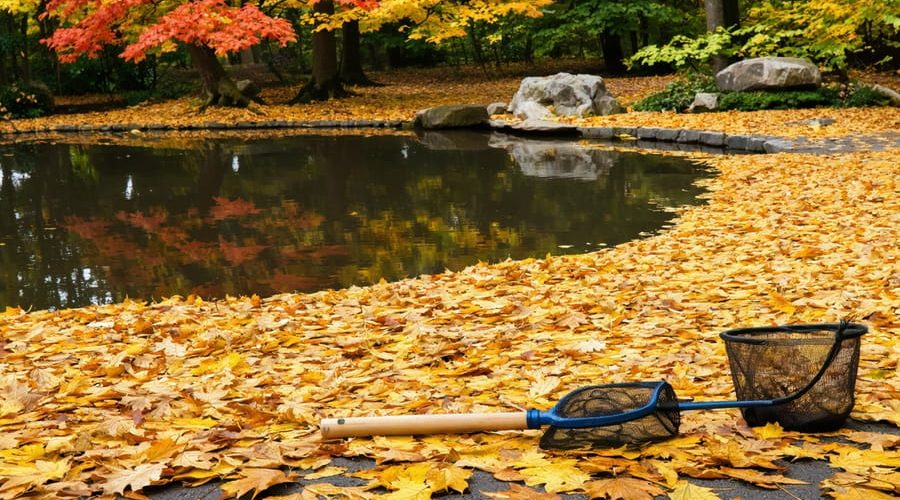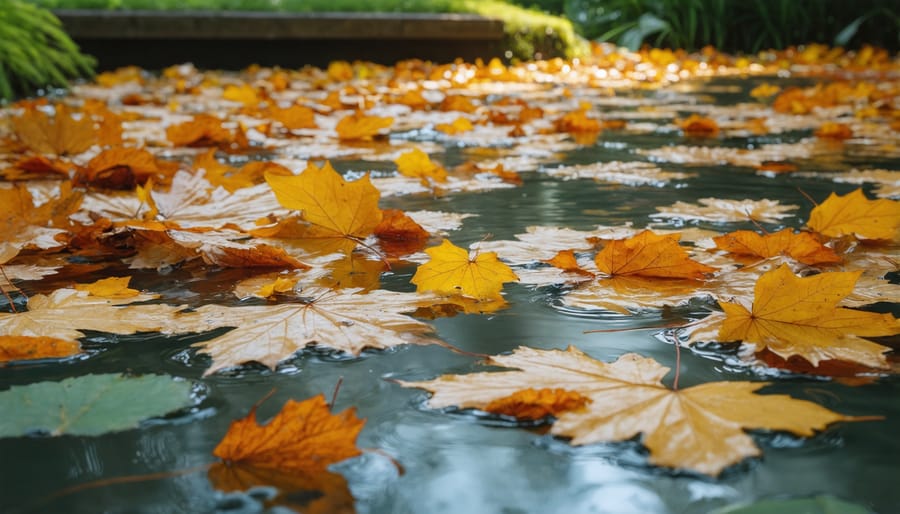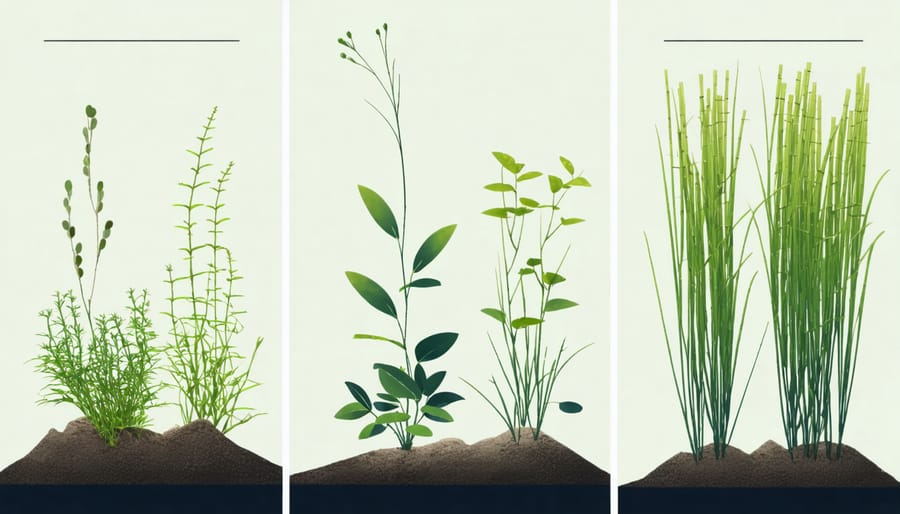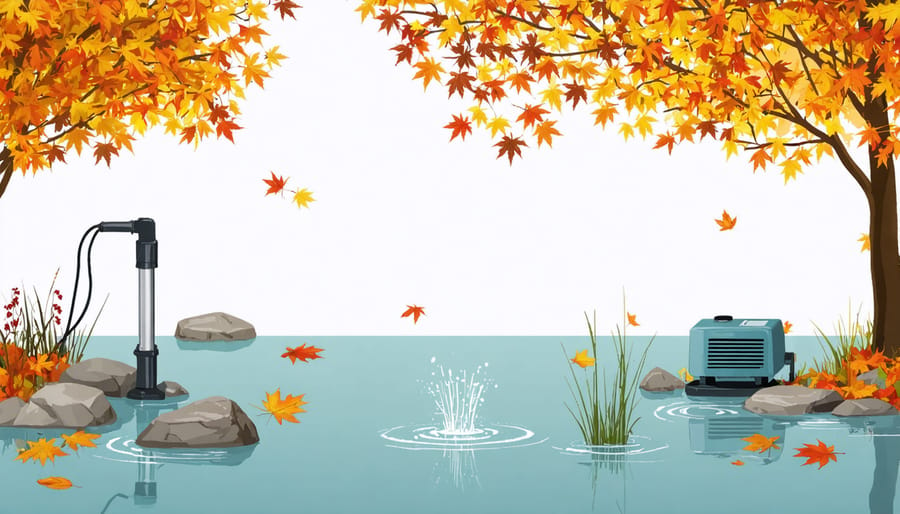
Keep Your Water Garden Thriving: Smart Autumn Prep That Actually Works
Autumn transforms water gardens into vibrant sanctuaries of gold and crimson, making it the perfect time to prepare your pond for the cooler months ahead. Start by removing fallen leaves daily using a fine-mesh net, preventing organic matter from decomposing and compromising water quality. Trim back dying aquatic plants to 2-3 inches above the water line, maintaining essential winter coverage while removing potential debris sources. Adjust your filtration system and consider installing a pond net to protect against falling leaves – these winter preparation tips will ensure your water garden transitions smoothly through the season. Check water temperature weekly, gradually reducing fish feeding as temperatures drop below 10°C (50°F). This magical transition period offers a unique opportunity to enhance your pond’s natural beauty while protecting its delicate ecosystem for the months ahead.
Why Your Water Garden Needs Special Attention in Fall
Temperature Changes and Your Pond’s Ecosystem
As autumn progresses, your pond undergoes significant changes due to falling temperatures. When water temperatures drop, the oxygen levels naturally increase, which might seem beneficial at first. However, this change affects your entire pond ecosystem in several important ways.
Your fish will become less active as their metabolism slows down, requiring less food and using less energy. This is their natural way of preparing for winter. The beneficial bacteria in your pond also slow their activity, which means decomposition of organic matter happens more slowly.
Plant life responds too – water lilies start to yellow and sink, while oxygenating plants may begin to die back. This is completely normal and part of the natural cycle. The changing temperature can also affect your water’s pH levels and create conditions where falling leaves decompose more slowly.
To help your pond adapt, gradually reduce feeding as temperatures fall below 10°C (50°F). Keep an eye on your water quality, but avoid making dramatic changes to your pond chemistry during this sensitive transition period. Remember, these changes are natural and your pond’s ecosystem is designed to handle them.
The Falling Leaves Dilemma
As autumn sets in, falling leaves create a beautiful spectacle but can pose challenges for your water garden. These leaves, while picturesque on trees, can become problematic when they land in your pond or water features. When left unchecked, decomposing leaves release tannins and excess nutrients into the water, potentially affecting its clarity and quality.
The impact goes beyond aesthetics – fallen leaves can clog filtration systems and pumps, reducing their efficiency and potentially leading to equipment damage. As leaves sink and decompose, they create a layer of organic matter at the bottom of your pond that can alter the water chemistry and affect fish health.
To maintain clear, healthy water during autumn, regular skimming becomes essential. Using a pond net or skimmer helps catch leaves before they sink. Consider installing a pond cover net early in the season – it’s much easier to collect leaves from above than to remove them once they’ve settled in the water. For smaller water features, floating balls can help prevent leaves from settling while maintaining visual appeal.
Remember to check your filtration system more frequently during this season, as it works harder to process the additional organic matter.
Essential Autumn Maintenance Steps

Smart Debris Management
Fall brings a beautiful display of colors, but it also means dealing with fallen leaves in your garden. The key to smart debris management is being proactive rather than waiting until your garden is completely covered. Start by installing leaf nets or screens over your pond before leaves begin to fall heavily. These protective barriers catch debris before it can sink and decompose in your water.
For garden paths and beds, consider using a mulching mower instead of raking. This turns fallen leaves into natural fertilizer that enriches your soil over winter. If you prefer traditional raking, create designated collection areas where leaves can decompose naturally into leaf mold – a valuable garden resource.
Don’t forget about your gutters and drainage systems. Regular cleaning prevents blockages that could lead to water damage or overflow into your garden. A simple gutter guard can significantly reduce maintenance needs.
For stubborn wet leaves, try using a leaf vacuum or blower when the debris is slightly damp – this prevents leaves from flying everywhere while making collection easier. Create a composting system specifically for autumn debris, alternating layers of leaves with green material to speed up decomposition.
Remember to check around pond pumps and filters regularly, as even small amounts of debris can affect their performance. Keep some space clear around water features to prevent leaves from getting trapped and causing maintenance issues later.
Plant Care and Trimming
As autumn approaches, it’s crucial to prepare your aquatic plants for the cooler months ahead. Start by removing any yellowing or dead foliage from floating and marginal plants, cutting stems back to about 2-3 inches above the water line. This prevents decaying material from sinking and affecting water quality.
For hardy water lilies, trim off dying leaves and flowers, but keep the crown intact. Lower these plants to the deepest part of your pond where they’ll be protected from freezing temperatures. Tropical water lilies, however, need to be removed and stored indoors in containers with damp sand.
Marsh plants and bog garden specimens should be cut back to about 6 inches above soil level. Apply a layer of mulch around bog plants to insulate their roots, but be careful not to let the mulch fall into the pond water.
Don’t forget about submerged oxygenating plants – while they don’t need extensive trimming, remove any struggling or dying portions to maintain water quality. For container pond plants, consider moving them to a sheltered location or greenhouse if you live in a particularly cold region.
Remember to collect all plant debris as you trim, as decomposing material can harm fish and encourage algae growth. Store any removed tropical plants in a frost-free environment, keeping them slightly moist but not waterlogged throughout winter.

Water Quality Maintenance
As autumn approaches, managing water quality changes becomes crucial for maintaining a healthy garden pond. The falling leaves and cooling temperatures can significantly impact your water parameters, requiring extra attention during this transitional period.
Start by testing your water weekly for pH, ammonia, and nitrate levels. Autumn’s organic matter decomposition can cause these values to fluctuate more than usual. Keep your pH between 6.8 and 7.8 for optimal conditions. If you notice any sudden changes, adjust gradually using appropriate water treatments.
Consider installing a pond net to catch falling leaves before they sink and decay. This simple step prevents excess nutrients from building up and affecting water quality. Regular skimming of floating debris also helps maintain clear, healthy water.
As temperatures drop, beneficial bacteria become less active. Support your pond’s biological balance by adding cold-water beneficial bacteria products specifically designed for autumn conditions. These help break down organic matter more efficiently.
Monitor water clarity and use a good quality pond vacuum to remove settled debris from the bottom. Remember to perform partial water changes (about 15-20%) monthly, but ensure the replacement water is dechlorinated and similar in temperature to avoid shocking your fish.
Keep your filtration system running efficiently by cleaning it more frequently during this season. Remove trapped debris and rinse filter media in pond water to preserve beneficial bacteria colonies while maintaining proper water flow.
Protecting Your Pond Life
Fish Care During Temperature Changes
As temperatures drop in autumn, your pond fish need special attention to maintain their health and vitality. Fish metabolism slows down significantly when water temperatures fall below 10°C (50°F), requiring adjustments to their feeding routine. Start by reducing the amount of food you offer and switch to a wheat germ-based food, which is easier for fish to digest in cooler conditions.
Monitor your fish closely during this transition period. When temperatures consistently stay below 8°C (46°F), stop feeding altogether, as your fish will naturally enter a period of dormancy. Don’t worry – they have built up enough reserves during summer to sustain them through winter.
Keep an eye on their behavior during autumn. Healthy fish should remain active, though slower than in summer. If you notice any unusual swimming patterns or fish gasping at the surface, check your water parameters immediately and ensure your pond has adequate oxygen levels.
This is also the perfect time to perform a final health check before winter. Look for signs of parasites or infections that could become problematic during dormancy. Remove any fallen leaves promptly, as decomposing organic matter can affect water quality and stress your fish when they’re most vulnerable.
Consider installing a pond net to prevent leaves from falling in and maintain a small hole in the ice during winter for gas exchange. These simple steps will help your finned friends transition comfortably through the seasonal change.
Beneficial Bacteria Management
As temperatures drop in autumn, maintaining beneficial bacteria in your water garden becomes crucial for a healthy ecosystem. These microscopic helpers break down organic matter and keep your water clear, but they become less active in cooler conditions. To support them, gradually reduce feeding your fish as this creates less waste for the bacteria to process.
Consider adding specialized cold-water bacterial supplements designed to work in autumn temperatures. These products contain strains that remain active even when it’s chilly. Apply them in the morning when water temperatures are rising, giving the bacteria the best chance to establish themselves.
Keep your filter media clean but avoid thorough cleaning that might remove too many beneficial bacteria colonies. A gentle rinse in pond water, rather than tap water, preserves these important microorganisms. If you’re using bio-media in your filtration system, don’t replace it during autumn as it houses valuable bacterial colonies.
Removing excess debris before it decomposes helps reduce the workload on beneficial bacteria. Use a net to skim fallen leaves regularly, and trim dying plant material promptly. This prevents organic matter from overwhelming your biological filtration system when bacterial activity is naturally slowing down.
Remember that a balanced bacterial ecosystem in autumn sets the stage for a healthier pond come spring, so taking these steps now will pay off in the long run.
Equipment Preparation for Colder Weather
Filtration System Adjustments
As autumn approaches, your pond’s filtration system needs some thoughtful adjustments to handle falling leaves and changing water conditions. Start by checking your pump’s flow rate – you might want to reduce it slightly to match the decreased biological activity in cooler temperatures. This helps maintain efficient filtration without unnecessarily stirring up settled debris.
Clean your filter media thoroughly before the heavy leaf fall begins. Remove any accumulated debris and rinse the media in pond water (never tap water) to preserve beneficial bacteria. Consider adding filter media bags or nets around your intake pipes to catch leaves before they enter the system.
If you use a UV clarifier, you can typically reduce its running time or turn it off completely as algae growth naturally slows down in autumn. This saves energy and extends the life of your UV bulb. However, keep your biological and mechanical filtration running 24/7 to maintain water quality.
For skimmer systems, check and empty the collection basket more frequently during this season. Installing a pond net above your water feature can significantly reduce the strain on your filtration system by catching leaves before they sink.
Remember to monitor your water parameters regularly during this transition period. If you notice any issues with water clarity or quality, adjust your filtration accordingly rather than waiting for problems to develop.
Pump and Aerator Considerations
As autumn approaches, maintaining proper water circulation and oxygenation becomes crucial for your pond’s health. Your pump and aerator system plays a vital role in creating natural water circulation, which helps prevent stagnation and keeps your aquatic ecosystem thriving.
During fall, check your pump’s intake regularly for accumulated leaves and debris. A clogged pump can reduce water flow and strain the motor, potentially leading to damage. If you notice reduced water flow, give your pump a thorough cleaning and ensure all moving parts are working smoothly.
Consider adjusting your aerator settings as temperatures drop. While oxygen levels naturally increase in cooler water, maintaining consistent aeration helps break down falling leaves and prevents ice formation in colder regions. Position your aerator to create gentle movement across the pond’s surface without disturbing the warmer bottom layers where fish may gather.
For pond owners in mild climates, you can continue running your pump throughout autumn. However, if you experience freezing winters, plan to either move your pump to a frost-free location or install a de-icer before the first frost. Remember to clean and inspect all equipment before storage, replacing any worn parts to ensure everything’s ready for spring startup.
A well-maintained circulation system in autumn sets the foundation for a healthy pond through winter and into the following season.

As autumn winds down, taking these essential steps to prepare your garden will ensure a healthy and vibrant return in spring. Remember to gradually reduce feeding as temperatures drop, remove fallen leaves regularly to prevent water contamination, and trim back dying foliage from aquatic and marginal plants. Don’t forget to check your pond equipment, particularly pumps and filters, cleaning them thoroughly before winter sets in.
For those in colder regions, now is the time to consider installing pond netting or a floating heater to protect both your fish and the pond’s structure during freezing temperatures. If you haven’t already, make sure to document your garden’s current layout and take photos – this will be invaluable for planning next year’s arrangements and identifying any areas that need improvement.
Store your tender plants and tropical varieties in appropriate indoor spaces, ensuring they’re free from pests and diseases before bringing them inside. This is also the perfect time to make notes about what worked well this season and what you’d like to change next year.
By following these autumn preparation steps, you’ll not only protect your garden through the winter months but also set yourself up for a successful spring season. Remember, autumn gardening isn’t about closing shop – it’s about smart preparation for the cycle of growth to come.
Take advantage of these cooler days to get these tasks done at a comfortable pace, and your garden will thank you when spring arrives.
